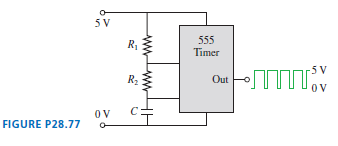Digital circuits require actions to take place at precise times, so they are controlled by a clock
Question:
Digital circuits require actions to take place at precise times, so they are controlled by a clock that generates a steady sequence of rectangular voltage pulses. One of the most widely used integrated circuits for creating clock pulses is called a 555 timer. FIGURE P28.77 shows how the timer??s output pulses, oscillating between 0 V and 5 V, are controlled with two resistors and a capacitor. The circuit manufacturer tells users that TH, the time the clock output spends in the high (5 V) state, is TH= (R1+ R2) C × ln 2. Similarly, the time spent in the low (0 V) state is TL= R2C × ln 2. You need to design a clock that will oscillate at 10 MHz and will spend 75% of each cycle in the high state. You will be using a 500 pF capacitor. What values do you need to specify for R1and R2?

Step by Step Answer:

Physics for Scientists and Engineers A Strategic Approach with Modern Physics
ISBN: 978-0133942651
4th edition
Authors: Randall D. Knight





